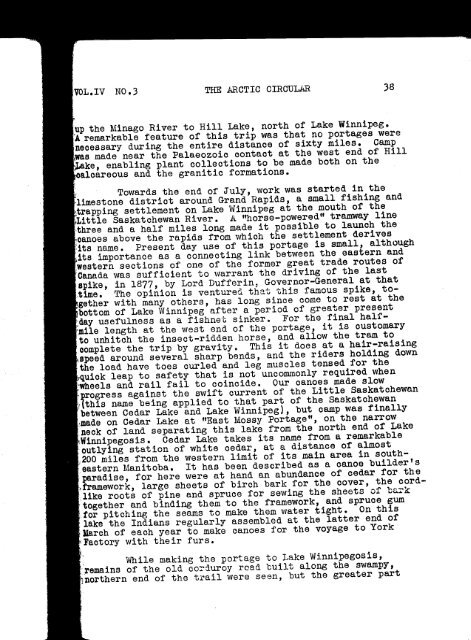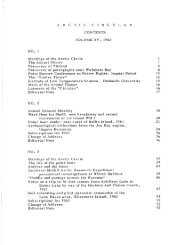Volume 4, 1951 - The Arctic Circle - Home
Volume 4, 1951 - The Arctic Circle - Home
Volume 4, 1951 - The Arctic Circle - Home
You also want an ePaper? Increase the reach of your titles
YUMPU automatically turns print PDFs into web optimized ePapers that Google loves.
up the Minago River to Hill Lake, north of Lake Winnipeg.<br />
A remarkable feature of this trip was that no portages were<br />
necessary during the entire distance of sixt Y miles. Camp<br />
,~aa made near the Palaeozoio oontaot at the west end of Hill<br />
~ke, enabling plant oolleotions to be made both on the<br />
aloareous and the granitio formations.<br />
< Towards the end of July, work was started in the<br />
'limestone distriot around Grand Rapids, a small fishing and<br />
trapping settlement on Lake Winnipeg at the mouth of the<br />
'~LittleSaskatohewan River. A "horse-powered" tramway line<br />
three and a half miles long made it possible to launoh the<br />
~oanoes above the rapids from whioh the settlement derives<br />
]ta name. Present day use of this portage is small, although<br />
,its importance as a connecting link between the eastern and<br />
~estern sections of one of the former great trade routes of<br />
'Canada was sufficient to warrant the driving of the last<br />
spike, in 1877, by Lord Dufferin, Governor-General at that<br />
,time. <strong>The</strong> opinion is ventured that this famous spike, together<br />
with many others, has long since come to rest at the<br />
bottom of Lake Winnipeg after a period of greater present<br />
'2dayusefulness as a fishneti sinker 0 For the final half-<br />
~ile length at the west end of the portage, it is customary<br />
to unhitoh the insect-ridden horse, and allow the tram to<br />
complete the trip by gravity. This it does at a hair-raising<br />
\speed around several sharp bends, and the riders holding down<br />
the load have toes curled and leg muscles tensed for the<br />
quiok leap to safety that is not uncommonly required when<br />
'~heels and rail fail to ooincide. Our canoes made slow<br />
'progress against the swift current of the Little Saskatchewan<br />
)(this name being applied to that part of the Saskatohewan<br />
between Cedar Lake and Lake Winnipeg), but camp was finally<br />
tmade on Cedar Lake at "East Mossy Portage", on the narrow<br />
neok of land separating this lake from the north end of Lake<br />
,Winnipegosis. Cedar Lake takes its name from a. remarkable<br />
outlying station of white cedar, at a distance of almost<br />
200 miles from the western limit of its main area in southeastern<br />
Manitoba. It has been described as a oanoe builder's<br />
paradise, for here were at hand an abundance of cedar for the<br />
jframework, large sheets of birch bark for the oover, the cordlike<br />
roots of pine and spruce for sewing the sheets of ba~k<br />
together and binding them to the framework, and spruoe gum<br />
for pitching the seams to make them water tight. On this<br />
lake the Indians regularly assembled at the latter end of<br />
March of eaoh year to make canoes for the voyage to York<br />
.1 Factory wi th the ir fur s •<br />
While making the portage to IJake Winnipegosis,<br />
~emains of the old co~1uroy road èuilt along the swampy,<br />
,northern end of the trail were seen, but the greater part












